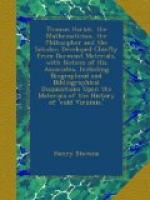(then in the height of his dignity and employments)
gave order for a search to be made, and in result
the answer was, they could not be found.
I am afraid the search was but perfunctory, and
that, if his lordship (now at leisure) were solicited
for them, he might write to his son the Lord Cornbury
to make a diligent search for them. One Mr. Protheroe,
in Wales, was executor to Mr. Harriot, and from him
the Lord Vaughan, the Earl of Carbery’s
son, received more than a quire of Mr. Harriot’s
Analytics. The Lord Brounker has about two
sheets of Harriot de Motu et Collisione Corporum,
and more of his I know not of: there is nothing
of Harriot’s extant but that piece which
Mons. Garibal hath.
Collint to Vernon,
not dated but circa 1671, vol. i, page
153.
Upon this passage Professor Rigaud makes the following note, written at Oxford in 1841:
Harriot’s will is not to be found, but Camden says that he left his property to Viscount Lisle and Sir Thomas Aylesbury. Lord Lisle’s share of the papers appear to have been given up to his father-in-law, Henry earl of Northumberland, who had been Harriot’s munificent patron, and they descended with the family property to the E. of Egremont, by whom a large portion has been given to the British Museum, and the remainder are still preserved at Petworth. Sir Thomas Aylesbury’s share became the property of his son-in-law Lord Chancellor Clarendon, to whom the Royal Society applied, but, as it appears, without obtaining them. (See Birch, Hist. Royal Society, vol. ii, pp. 120, 116, 309.)-Vol. i, page 153.
Here seems to be the germ of Professor Wallis’s charge of plagiarism against Descartes, written to Collins twelve years before it appeared in thefirst editionof his History of Algebra in English in 1685. It subsequently took a wider range, and was strenuously defended by Wallis when opposed:
That which I most valued in his [Des Cartes] method, and which pleased me best, was the way of bringing over the whole equations to one side, making it equal to nothing, and thereby forming his compound equations by the multiplication of simples, from thence also determining the number of roots, real or imaginary, in each. This artifice, on which all the rest of his doctrine is grounded, was that which most made me to set a value on him, presuming it had been properly his own; but afterwards I perceived that he had it from Hariot, whose Algebra was published after his death in the year 1631, six years before Des Cartes’ Geometry in French in the year 1637 : and yet Des Cartes makes no mention at all of Harriot, whom he follows in designing his species by small letters, and the power: of them by the number of dimensions, without the characters of j, c, qq, &c.
Walla to Collins,
Oxford, 12 April 1673, vol, ii, page
573.




